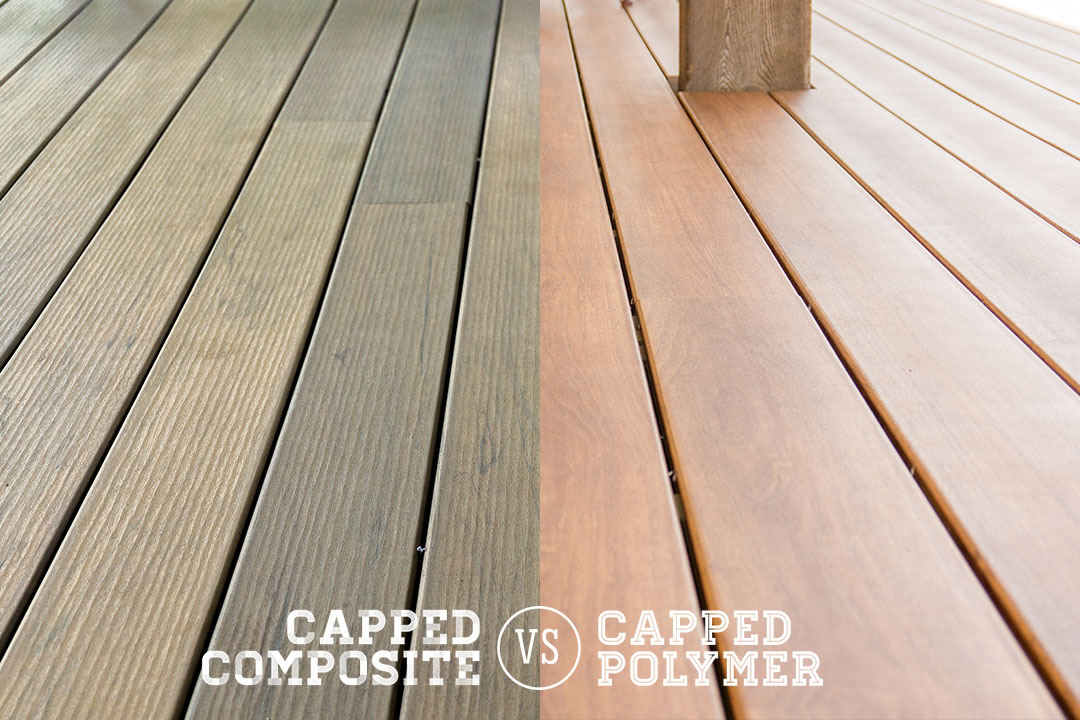Capped Composite and Capped Polymer (100% PVC) decking are excellent options for any outdoor space. Unlike real wood, they are virtually maintenance free, splinter free, highly durable against the elements, and easy to clean. However, trying to choose between the two can get confusing. In the end it comes down to what works best for your deck needs, wants, and budget. Here we introduce the differences and similarities between Capped Composite and Polymer decking to help you make the best decision for your next project.
Trex Transcend Havana Gold | Azek Arbor Brazilian Walnut
How is it made?
Capped Composite decking has an inner core made of recycled wood and plastics. As its name suggests, the core of the composite is then “capped” by a PVC shell that helps protect it from the elements. Capped Composite decking is generally made from 75-95% recycled material.
On the other hand, Capped Polymer – made with 100% PVC (Polyvinyl Chloride) – decking contains no wood fibers at all. The synthetic material is incredibly durable. Installation requires a little more skill than Capped Composite, but it's more resistant to staining, fading, and scratching over time. Since Capped Polymer decking is 100% plastic, it expands and contracts during changes in temperature slightly more than Capped Composite decking.
TimberTech Legacy Mocha | Zuri Premium Decking Pecan
Which looks more like real wood?
Beauty is in the eye of the beholder, so it’s hard to definitively say which product looks and feels more like wood. Capped Polymer decking has made vast improvements in looking like wood. For example, Zuri Premium Decking overlays a picture of real wood on the top of the deck board. Most Capped Composite and Capped Polymer decking uses an extrusion process that creates a wood grain look and feel that closely resembles the real thing.
Can you stand the heat?
All composite decking will absorb a little more heat than real wood, making it hotter to the touch when exposed to the sun for long periods of time. Between composites, Capped Polymer decking will retain less heat and dissipate heat quicker than Capped Composite. At the end of the day, the difference in heat retention on a hot summer day between real wood, Capped Composite, and Capped Polymer is fairly insignificant; they are all hot!

Fiberon Horizon Ipe | Azek Harvest Autumn Chestnut
How much are we talking?
Let's face it, Capped Polymer and Capped Composite decks are going to be more expensive on the front-end than a Cedar or Treated-Pine deck. However, the cost and time savings on maintenance can quickly make up for the additional up-front costs. For a 200 sq. ft. deck, you can expect to spend around $4K-$6K USD in materials for Capped Composite and $5K-$8K USD on Capped Polymer decking.
How long will it last?
For both capped products, you can count on at least a 25-year stain and fade warranty. And while most Capped Composites have a 25-year warranty against any termites or rot, some Capped Polymer brands boast a lifetime warranty against termites and rot. Yes, Capped Polymer decking is more expensive, but it offers greater longevity than Capped Composite when it comes to scratching and overall durability.

Trex Transcend Havanna Gold | Azek Harvest Autmun Chestnut
Which is the better choice?
While Capped Polymer decking is generally more expensive, it will probably stand the test of time better than a Capped Composite deck. On the other hand, choosing a Capped Composite still gives you a beautiful, durable, and maintenance free outdoor space. Much of the time, the choice between which product to go with comes down to the color you like the most.
 English
English Português
Português  简体中文(中国)
简体中文(中国) 





